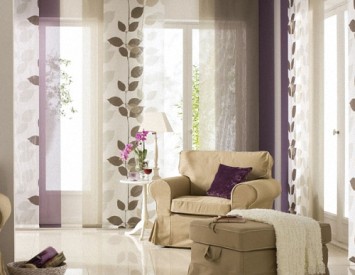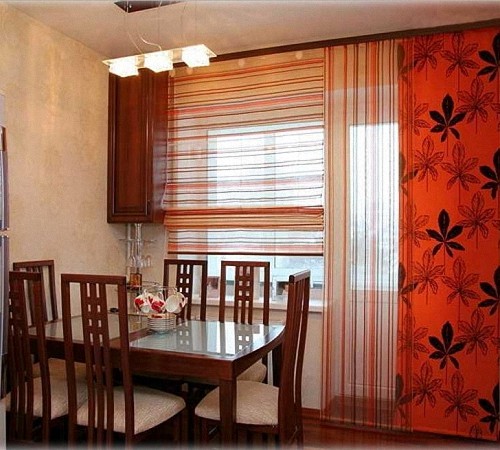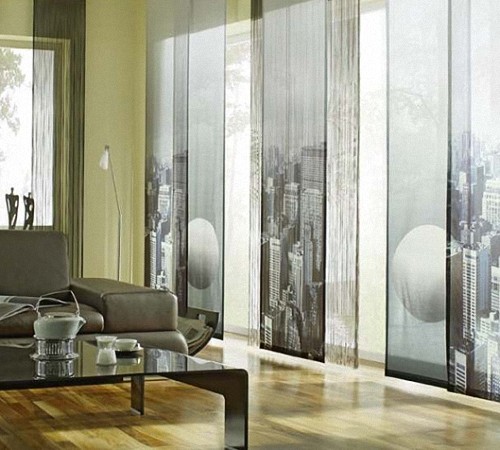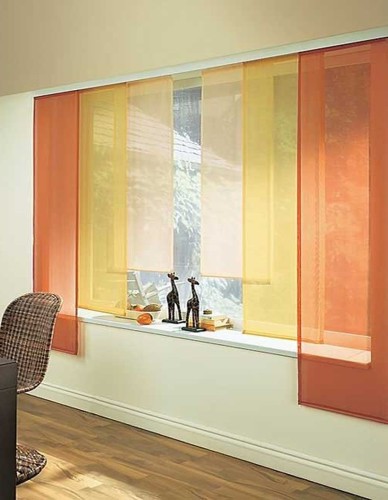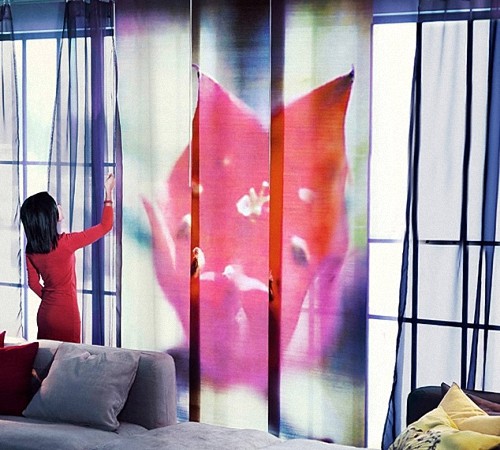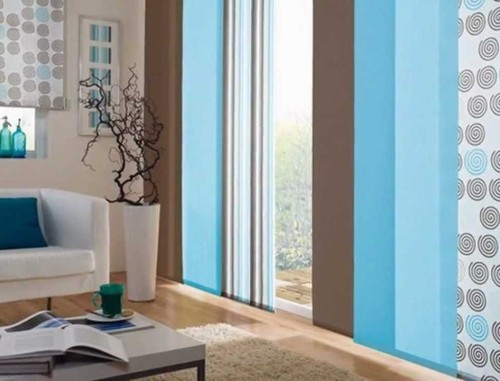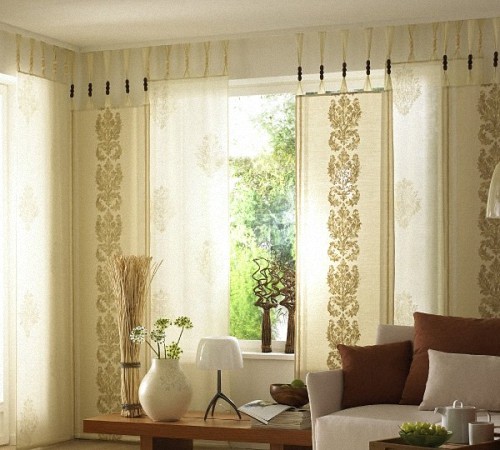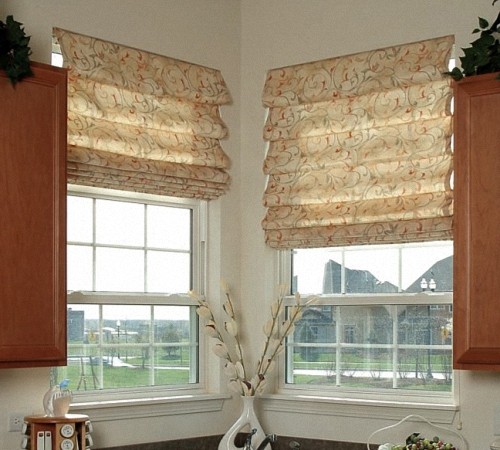Many fans of Japanese culture delights their way of life, perseverance, hard work, balance, as well as their food, aesthetics and technical innovations in this nation. The most interesting style of the interiors of the country of the rising sun: low furniture, sliding doors and narrow Japanese curtains. The lifestyle on the islands, which regularly shakes and washes away, encourages the modest arrangement of the dwelling even with solid prosperity. Japanese minimalism is very in demand among eminent designers around the world, and simple and amazing curtains can be made independently for the European interior.
Content
Features of Japanese curtains
Japanese traditional curtains are not like our curtains and curtains. They are deprived of folds, ruffles, fringe and other jewelry, and more reminiscent of fabric narrow panels that are made of dense and light translucent material.
Although there are no special taboos regarding the print or color for Japanese curtain panels, the Japanese themselves love natural discreet tones. Their color, most often, has a poetic definition - the shade of the flowering sakura, the delicate shoots of bamboo, etc. But Japanese curtains have a width restrictions - no more than 60 cm for each panel, which can be several, moreover with a different pattern. Because of this, large prints are not too wide, and if they are conceived from different panels, then no more than 2-3 types of fabric are used that harmonize and complement the image.
Looking through samples of Japanese curtains in the photo, it is obvious that eastern symbolism or hieroglyphs are not required here, although they are not excluded. The colors and attributes of the Japanese flag are rarely used, but red in combination with white are very appropriate. If necessary, man -made hieroglyphs are created on the panels, which are easier to sew out of braid or stuffed with a printed print. Although the fabric strip is supposed to be no more than 60-90 cm, wide windows or a whole wall are closed by a combination of several sliding screens.
Japanese curtains are always the same length - almost to the floor. They are stretched without folds on special cornices. They are not extended according to the type of ordinary, that is, they do not plunge in the usual sense, but only move along the window. That is why they are sometimes called “screen” or “panel” curtains. At the top of their ideal tension, the cornice helps, and from below they contain stiff inserts.
They somewhat resemble wide blinds, the principle of fastening is about the same, and it was Japanese curtains that served as an idea for them. Such curtains can be completely motionless, combining transparent and dense panels, like two -layer curtains familiar to us. There are sliding structures controlled by the remote control and pushed out with the help of a cord, like blinds. And although the curtains are removed symmetrically on both sides of the windows, only one half can be set in motion, for example, at the balcony door.
After sewing Japanese curtains, the fabric is well ironed and pulled, like a screen. Usually they are not touched by their hands, and in this form they serve for a long time. It is easy to spill them, holding from below, but the capacity of the vacuum cleaner should be minimal. As the curtains are contaminated, it is easy to remove, wash and hang again. Sometimes, to update the general design, they change part of the panels, creating a new appearance of Japanese curtains in the interior.
Decorative solution
The popularity of the design of Japanese curtains is explained by their multifunctionality. Screening with rectangular fabric linems is used not only in the form of window curtains, but also as screen or panels for zoning the interior, as well as for decorating the wall. For example, they can separate the personal space in a room for 2-3 children, hide shelves for needlework or a place for a rest of an elderly person. In addition to windows, Japanese curtains can be used for doorways or to close the shelves and niches that do not have a door.
Adherents of Japanese minimalism and eco -style use Japanese curtains in the interior to hide those things that do not fit into the overall concept from the general view. For example, a storyteller with aquariums for breeding fry or a corner with a sewing machine. When choosing materials, they prefer natural fabrics or combination of fabrics of different textures.
In most cases, canvases for Japanese curtains are limited to 60 cm wide - this was what used the standard of the Suvoi canvas, but a special cornice was adapted for them.
Advantages of Japanese curtains
Japanese -style screen curtains have become an interesting alternative to European aesthetics in design. They have a number of undeniable advantages:
- grace and simple geometry, calm shades;
- they are suitable for windows of any width due to their combinators;
- any person who has the basics of working as a sewing machine can sew a set of Japanese curtains;
- curtains save a place;
- even the most budget fabrics are suitable for them;
- curtains help to regulate the flow of natural light and air even in a curtained form;
- help create a creative appearance in the apartment;
- do not require expensive accessories;
- they have no restrictions on choosing the texture of fabric;
- there are no folds and the possibility of dust accumulation on Japanese panels;
- create a natural barrier to penetrate insects;
- they are rarely washed, it is convenient to clean them with a vacuum cleaner;
- a special cornice will ensure the simplicity of use, including remotely;
- they do not need complex care after washing and ironing, the fabric is many times hanged and removed;
- finished cornices can be bought in catalogs or in stores;
- it is possible to use the advice of professionals - Japanese curtains master class.
The choice of fabric for sewing Japanese curtains
In the author’s interior there is always a place for creative accessories, such as Japanese curtains. They will adorn not only the Japanese interior, but also any modern design, depending on the combination of panels color and the texture of the material. The alternation of greedy white panels of the translucent texture and dark jacquard on wide window openings looks very interesting.
A great choice is to hang Japanese curtains between the kitchen and the dining room in the studio apartment, and you can separate the hallway and living room. Fabric of washing material according to the type of Japanese curtains can also find use in the bathroom or in the bathroom.
Japanese curtains in the interior always emphasize the originality of the idea-from conservative-classical to the most futuristic style, especially if they are somehow unusual to beat. When choosing fabric in color, density and texture, it is important to consider the width of the paintings so that a large pattern fit into the panels without pruning. Plain contrasting canvases will help in an original way to decorate the business office.
Usually, light fabrics, transparent and translucent are selected for the screen type of curtains. It is important that they miss enough light and air from an open transom. The width of the panels is limited by a special Japanese cornice, and in order not to process sidewalls, it is easier to immediately buy a fabric with a width of exactly 60 cm.
However, if they are attached in another way, for example, on a ceiling cornice, then you can buy a fabric wider - up to 90 cm. Divide the length of the cornice over the window opening by the number of the alleged panels if the mount is unconventional, for example, a little overlap.
In calculations, how much fabric for curtains is required, it is important to navigate:
- on the possibility of a Japanese cornice;
- to the height of the wall and the required number of screens.
Next, about 10 cm is added to the length of the panels for the allowance for the processing of the fabric from above and below. Remember that a rigid part is inserted into the lower part to maintain the form. On the sides on the sides of the panels and on the side seams make a allowance of 5 cm.
For classic Japanese curtains, narrow canvases made of natural fabrics are selected, for example, flax, cotton, silk or traditional canvases from bamboo fibers. You can also use jute fabrics with an original weave of rude threads. For a modern eclectic design, you can make Japanese curtains with your own hands from those fabrics that will be most appropriate in the general idea.
Hard fabrics are best kept in shape, do not stretch and are not deformed with prolonged use. Under the planks, the curtains are like a wood or metal for the bottom, it is important that they record a traditional shape. Regarding the pattern - it is better to take an discreet picturesque print with the image of plants and animals, hieroglyphs and oriental symbols.
The classic of the Japanese style is delicate and calm tones: white and blue, beige and brown, light green and sand, pale pink or peach. Light plain panels are designed to bring peace, purity and general harmony into the traditional Japanese interior. To create an optimistic and cheerful mood, 3-2 bright canvases of yellow, red or orange are added.
Multifunctionality of Japanese curtains
Japanese curtains - original and multifunctional design solution:
- the window completely closed by the translucent screen can hide the dull landscape of the industrial zone or protect you from curious eyes from closely located windows opposite;
- when zoning the space, the curtains are used to separate different parts of the dwelling;
- experiments with texture and color help to create a special comfort to separate the personal space, emphasizing the individuality of the residents;
- it is possible to use curtains to shield jobs in a large office room;
- curtains help create an original design of doorways;
- the parts of the room that need to be hidden from the general review are well hidden;
- act as a natural protection against insect penetration;
- it can be used to decorate the nursery so that the falling asleep child is not distracted by movement around the apartment of other family members.
Cornices for Japanese curtains
For Japanese curtains, ordinary cornices are not used, since they do not support the shape of the screen panel, and the movement of the stretched canvas is difficult to manually. Thanks to the special guided cornices, Japanese curtains with a metal heavier are attached from above on Velcro to the rails moving using a control device. The cornice has a different amount of controlled panels, it all depends on the maximum length of the cornice itself and the width of the panels attached to it-from 3 to 6. The cornices consist of the rails, along which the panels are moved to the right and left.
The management of classic Japanese curtains was provided on a special cord, which moved the panels. The system resembles blinds, and here you can use glass curtains. But today they prefer the automatic control of the cornice with the remote control. However, Japanese curtains can not close at all for a long time, especially when the fabric is selected in such a way that the curtain passes a lot of light, but hides visibility from the outside of the window.
There are different options for curtains for curtains, for example, a 3-strip profile is enough on a screen of three to five panels, and up to 6-7 cloths can be attached to 4-strip profiles. The maximum length of the cornice for Japanese curtains is 8 m, but if you want to increase the length, you can mount 2 cornices in a row.
Cut and sewing of Japanese curtains
Japanese curtains Master class is a workshop that helps to correctly make Japanese curtains with your own hands. On it you can find out the advice of professionals in the video or study the step -by -step instructions.
- We start with the purchase of the cornice of the required length to determine the number of paintings.
- Buying fabric of the required meter depends on the length of future screens, their number and allowances for seams of 10 cm.
- The cutting of strips of 60 cm depends on the width of the tissue - if the fabric is more than 130 cm, then you can cut off 2 canvases from one piece at once.
- Natural fabrics give a shrinkage, so it is better to make the segments a little more. Then they need to be wetted, dried and ironed. If you wash the curtains in hot water, and rinse in the cold, there will be more shrinkage.
- Lateral allowances for seams are made less than below and from above.
- The processing of the seams begin on the sides, then sew the top to Velcro. From below it is necessary to pick up wide enough to make the wiretrum for a weighting agent.
- To save time, it is more convenient to perform the same operations at once on all panels.
- Velcro allowance is made small, up to 2 cm, and 4-5 cm under the backstage.
- The sewn curtain is first ironed, then the Velcro is attached. By the way, wet ironing in itself gives a shrinkage. The seams will be especially carefully ironed.
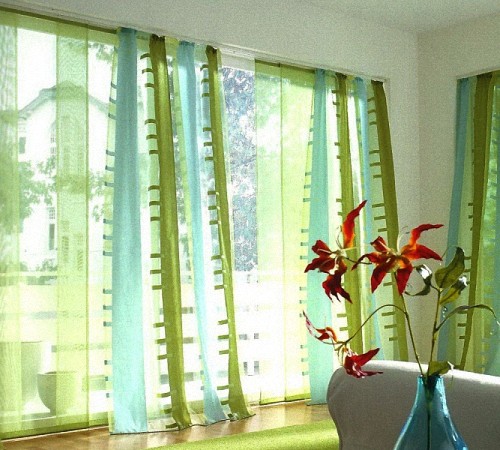
- On the upper cut of the canvas is applied with the front side of the Velcro, evenly fixed with pins, and scribbled. Then they bend inside out and sew again.
- If the fabric is greedy, then the entire panel is not ironed, but only a little steam the seams, putting a wet towel from below.
- Now you can hang a Japanese curtain on the cornice and pass weighting in the wiretrentry. If there is nothing suitable for this purpose, you can enter a wooden glazer or a long steel knitting needle.
Tip: The difficulty of sewing is to make all curtains of the same length. If there is a small difference, you can adjust in the backstage.
